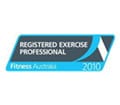If you find you are out of breath when exercising, it may not be your fitness level but incorrect breathing.
Most of us are chest breathers and are not aware of the significant benefits of breathing diaphragmatically. “It has been said that poor breathing plays a role in about 75% of the ills that cause individuals to see their doctor,” says Jonathon Sears, CHEK Practitioner.
This important role is acknowledged in many eastern practices like Yoga, Tai Chi, Qi Gong and even in different martial arts, and is becoming increasingly more acknowledged in high performance areas of sport.

So why is breathing important?
At a basic level, breathing provides oxygen to our cells but its impact is far greater than this.
According to Functional Medicine, the body is not comprised of separate systems but rather interdependent systems reliant on each other. As an example, diaphragmatic breathing massages the stomach, gallbladder, small and large intestines (digestive system) via peristaltic (worm like) movements, liver and spleen (immune system), bladder and colon (excretory system).
It also helps different pumps in the body, like the cerebral spinal fluid, to nourish and remove waste from the central nervous system. It also has connection to the heart (cardiovascular system) via the fascia and vena cava (main artery to the heart).
So you can see the simple act of breathing can impact almost all the the body systems and functions.
Chest vs diaphragmatic breathing
Using your chest as the main muscle to breathe will not allow you to get the maximum amount of oxygen, as opposed to diaphragmatic breathing. The greatest transfer of oxygen happens in the lower parts of the lung where the highest densities of blood capillaries are located around the alveoli. With chest breathing, less oxygen exchange occurs and this results in an increased work load with a higher number of breaths.
With approximately 22 000 chest breaths per day, we establish an incorrect muscle pattern rather than using the most important respiratory muscle – the diaphragm. The overworking of accessory muscles leads to shortening and tightness, predominately in the neck and chest, which can lead to increased stress, headaches and musculoskeletal problems. It also can lead to lengthening and weakness of the opposing muscles like the trapezius and rhomboid, which are important for optimal posture.
So to establish a new correct muscle pattern, it only takes as little as 10 minutes a day to focus on your breathing. This can improve your energy levels, posture, digestion, immune response, stress levels, sleep quality, and reduce muscle tightness and pain. Here is a great breathing exercise to start with.
If you are looking for more or different breathing techniques and exercise, we have another 5 available in our “Mindful breathing” guide. You can Download Here
Box Breathing exercise
- Start in a lying down position facing up.
- Place your hands on your abdomen near your belly button.
- Slowly inhale for 5 seconds through your nose and feel your belly raising.
- Pause for a count of 5 seconds.
- Slowly exhale for 5 seconds through your nose or mouth and feel your hands dropping.
- Pause again for 5 seconds.
- Repeat for 10 minutes.
Enjoy your new found calmness, focus and energy!
Cameron Corish has been caring and achieving results for the local Wishart, Mansfield and Mt Gravatt community for over 10 years. Together with the Core Health Coaching Team, he takes a multi-disciplined and holistic approach to health and fitness addressing the physical, mental and emotional aspects of one’s health.
Ready to feel and look your best? Come in for a FREE chat and see how we can transform your life. Call 0406 451 907 or email Cameron at cameron@corehealthcoaching.com.au

















[…] a quiet space, sit comfortably, and focus on your breath for a few minutes each […]